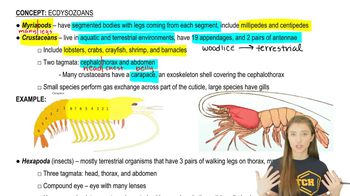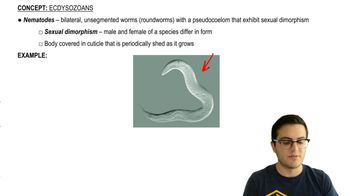Table of contents
- 1. Introduction to Biology2h 42m
- 2. Chemistry3h 40m
- 3. Water1h 26m
- 4. Biomolecules2h 23m
- 5. Cell Components2h 26m
- 6. The Membrane2h 31m
- 7. Energy and Metabolism2h 0m
- 8. Respiration2h 40m
- 9. Photosynthesis2h 49m
- 10. Cell Signaling59m
- 11. Cell Division2h 47m
- 12. Meiosis2h 0m
- 13. Mendelian Genetics4h 44m
- Introduction to Mendel's Experiments7m
- Genotype vs. Phenotype17m
- Punnett Squares13m
- Mendel's Experiments26m
- Mendel's Laws18m
- Monohybrid Crosses19m
- Test Crosses14m
- Dihybrid Crosses20m
- Punnett Square Probability26m
- Incomplete Dominance vs. Codominance20m
- Epistasis7m
- Non-Mendelian Genetics12m
- Pedigrees6m
- Autosomal Inheritance21m
- Sex-Linked Inheritance43m
- X-Inactivation9m
- 14. DNA Synthesis2h 27m
- 15. Gene Expression3h 20m
- 16. Regulation of Expression3h 31m
- Introduction to Regulation of Gene Expression13m
- Prokaryotic Gene Regulation via Operons27m
- The Lac Operon21m
- Glucose's Impact on Lac Operon25m
- The Trp Operon20m
- Review of the Lac Operon & Trp Operon11m
- Introduction to Eukaryotic Gene Regulation9m
- Eukaryotic Chromatin Modifications16m
- Eukaryotic Transcriptional Control22m
- Eukaryotic Post-Transcriptional Regulation28m
- Eukaryotic Post-Translational Regulation13m
- 17. Viruses37m
- 18. Biotechnology2h 58m
- 19. Genomics17m
- 20. Development1h 5m
- 21. Evolution3h 1m
- 22. Evolution of Populations3h 52m
- 23. Speciation1h 37m
- 24. History of Life on Earth2h 6m
- 25. Phylogeny2h 31m
- 26. Prokaryotes4h 59m
- 27. Protists1h 12m
- 28. Plants1h 22m
- 29. Fungi36m
- 30. Overview of Animals34m
- 31. Invertebrates1h 2m
- 32. Vertebrates50m
- 33. Plant Anatomy1h 3m
- 34. Vascular Plant Transport1h 2m
- 35. Soil37m
- 36. Plant Reproduction47m
- 37. Plant Sensation and Response1h 9m
- 38. Animal Form and Function1h 19m
- 39. Digestive System1h 10m
- 40. Circulatory System1h 57m
- 41. Immune System1h 12m
- 42. Osmoregulation and Excretion50m
- 43. Endocrine System1h 4m
- 44. Animal Reproduction1h 2m
- 45. Nervous System1h 55m
- 46. Sensory Systems46m
- 47. Muscle Systems23m
- 48. Ecology3h 11m
- Introduction to Ecology20m
- Biogeography14m
- Earth's Climate Patterns50m
- Introduction to Terrestrial Biomes10m
- Terrestrial Biomes: Near Equator13m
- Terrestrial Biomes: Temperate Regions10m
- Terrestrial Biomes: Northern Regions15m
- Introduction to Aquatic Biomes27m
- Freshwater Aquatic Biomes14m
- Marine Aquatic Biomes13m
- 49. Animal Behavior28m
- 50. Population Ecology3h 41m
- Introduction to Population Ecology28m
- Population Sampling Methods23m
- Life History12m
- Population Demography17m
- Factors Limiting Population Growth14m
- Introduction to Population Growth Models22m
- Linear Population Growth6m
- Exponential Population Growth29m
- Logistic Population Growth32m
- r/K Selection10m
- The Human Population22m
- 51. Community Ecology2h 46m
- Introduction to Community Ecology2m
- Introduction to Community Interactions9m
- Community Interactions: Competition (-/-)38m
- Community Interactions: Exploitation (+/-)23m
- Community Interactions: Mutualism (+/+) & Commensalism (+/0)9m
- Community Structure35m
- Community Dynamics26m
- Geographic Impact on Communities21m
- 52. Ecosystems2h 36m
- 53. Conservation Biology24m
31. Invertebrates
Ecdysozoans
Problem 2`
Textbook Question
What is the function of the arthropod exoskeleton?
a. The presence of an exoskeleton has given arthropods a good fossil record, because hard parts fossilize more readily than do soft tissues.
b. It has no well-established function. (Trilobites had an exoskeleton, and they went extinct.)
c. It provides protection and functions in locomotion.
d. It makes growth by molting possible.
 Verified step by step guidance
Verified step by step guidance1
Understand that the exoskeleton is a hard outer structure that covers the body of arthropods, such as insects, arachnids, and crustaceans.
Recognize that one of the primary functions of the exoskeleton is to provide protection to the organism. It acts as a barrier against physical damage and predators.
Consider the role of the exoskeleton in locomotion. The rigid structure provides points of attachment for muscles, allowing for movement.
Acknowledge that the exoskeleton also plays a role in growth. Arthropods must molt, or shed their exoskeleton, to grow larger, as the exoskeleton does not expand.
Evaluate the options given in the problem. Option c, 'It provides protection and functions in locomotion,' aligns with the known functions of the exoskeleton, while option d, 'It makes growth by molting possible,' also describes a key aspect of arthropod biology.
 Verified video answer for a similar problem:
Verified video answer for a similar problem:This video solution was recommended by our tutors as helpful for the problem above
Video duration:
56sPlay a video:
Was this helpful?
Key Concepts
Here are the essential concepts you must grasp in order to answer the question correctly.
Exoskeleton Structure
The exoskeleton is a rigid external covering that provides structural support and protection to arthropods. Composed primarily of chitin, it acts as a barrier against physical damage and desiccation. This hard outer layer is crucial for the survival of arthropods in various environments, offering a defense mechanism against predators and environmental hazards.
Recommended video:
Guided course

Community Structure
Protection and Locomotion
The exoskeleton serves dual functions: protection and locomotion. It shields internal organs from injury and provides attachment points for muscles, facilitating movement. This structural feature allows arthropods to perform complex movements and adapt to diverse habitats, contributing to their evolutionary success and ecological diversity.
Recommended video:
Guided course

2) mRNA Protection in the Cytoplasm
Molting Process
Molting, or ecdysis, is the process by which arthropods shed their exoskeleton to grow. As the exoskeleton does not expand, arthropods must periodically molt to increase in size. This involves forming a new, larger exoskeleton beneath the old one, which is then shed. Molting is a critical phase in the life cycle of arthropods, allowing for growth and development.
Recommended video:
Guided course

1) RNA Processing

 8:01m
8:01mWatch next
Master Arthropods and Chelicerata with a bite sized video explanation from Jason
Start learningRelated Videos
Related Practice












